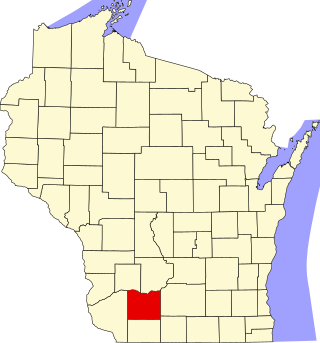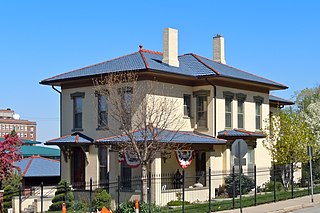
Council Bluffs is a city in and the county seat of Pottawattamie County, Iowa, United States. It is the most populous city in Southwest Iowa, as well as the third largest and a primary city of the Omaha-Council Bluffs Metropolitan Area. It is located on the east bank of the Missouri River, across from Omaha, Nebraska. Until about 1853 Council Bluffs was known as Kanesville. Kanesville was the historic starting point of the Mormon Trail. Kanesville is also the northernmost anchor town of the other emigrant trails because there was a steam-powered boat which ferried the settlers' wagons and cattle across the Missouri River. In 1869, the first transcontinental railroad to California was connected to the existing U.S. rail network at Council Bluffs.

Grenville Mellen Dodge was a Union Army officer on the frontier and a pioneering figure in military intelligence during the Civil War, who served as Ulysses S. Grant's intelligence chief in the Western Theater. He served in several notable assignments, including command of the XVI Corps during the Atlanta Campaign.

This is intended to be a complete list of the properties and districts on the National Register of Historic Places in Fairfield County, Connecticut, United States. The locations of National Register properties and districts for which the latitude and longitude coordinates are included below may be seen in an online map.

The Bisbee Mining and Historical Museum is a local history museum at 5 Copper Queen Plaza in Bisbee, Arizona. It is located in the Phelps Dodge General Office Building, a National Historic Landmark for the importance of the Phelps Dodge Corporation's role in the growth and development of the American Southwest. The museum is dedicated primarily to local history, particularly the town's founding and growth as a mining center.

The Dubuque County Jail is a historic building at 36 East 8th Street in Dubuque, Iowa, United States. Completed in 1858, the jail is an example of the uncommon Egyptian Revival style. It is architecturally a highly original work of John F. Rague, who also designed the 1837 Old Capitol of Illinois and the 1840 Territorial Capitol of Iowa. The building was designated a National Historic Landmark for its architecture in 1987. It served as a jail for more than a century, became a museum in 1975, and was converted into county offices in 2016.

The Farm House, also known as the Knapp–Wilson House, is the oldest building on the campus of Iowa State University in Ames, Iowa. Now a museum open to the general public, this house was built 1861-65 as part of the model farm that eventually became Iowa State. It was designated a National Historic Landmark in 1964 for its association with agriculturist and teacher Seaman A. Knapp and with U.S. Secretary of Agriculture James Wilson, both of whom lived here while teaching at Iowa State.

Highland Park is a historic park in Meridian, Mississippi, United States. Home to a museum honoring Jimmie Rodgers, a Meridian native, the site was listed on the National Register of Historic Places in 1979. The park is also home to the Highland Park Dentzel Carousel and Shelter Building, a National Historic Landmark manufactured around 1896 by Gustav Dentzel of Philadelphia, Pennsylvania. The historic carousel is the only two-row stationary Dentzel menagerie still in existence.

This is a list of the National Register of Historic Places listings in Iowa County, Wisconsin. It is intended to provide a comprehensive listing of entries in the National Register of Historic Places that are located in Iowa County, Wisconsin. The locations of National Register properties for which the latitude and longitude coordinates are included below may be seen in a map.

This is a list of the National Register of Historic Places listings in Crow Wing County, Minnesota. It is intended to be a complete list of the properties and districts on the National Register of Historic Places in Crow Wing County, Minnesota, United States. The locations of National Register properties and districts for which the latitude and longitude coordinates are included below, may be seen in an online map.

This is a list of the National Register of Historic Places listings in Olmsted County, Minnesota. It is intended to be a complete list of the properties and districts on the National Register of Historic Places in Olmsted County, Minnesota, United States. The locations of National Register properties and districts for which the latitude and longitude coordinates are included below, may be seen in an online map.

This is a list of the National Register of Historic Places listings in Benton County, Iowa.

This is a list of the National Register of Historic Places listings in Audubon County, Iowa.

This is a list of the National Register of Historic Places listings in Dodge County, Minnesota. It is intended to be a complete list of the properties and districts on the National Register of Historic Places in Dodge County, Minnesota, United States. The locations of National Register properties and districts for which the latitude and longitude coordinates are included below, may be seen in an online map.

The Council Bluffs Public Library serves the residents of Council Bluffs, Iowa, United States along with unincorporated and rural areas of Pottawattamie County. Several cities also contract with the library to provide services. It dates back to 1866. The library is currently located on Willow Avenue. The previous library building on Pearl Street was listed on the National Register of Historic Places in 1999.

The Foster/Bell House is an historic building located in Ottumwa, Iowa, United States. The original house on the property was the home of Judge H.B. Hendershott built in 1862. He sold the property to Thomas D. Foster in early 1890s. He was the chairman and general manager of the meat packing firm John Morrell & Company from 1893 to 1915. Foster hired architect Ernest Koch to design the present residence. It was originally a frame and stone house in the Neoclassical style that was completed in 1893. The house passed to Foster's daughter Ellen Foster Bell who hired the Des Moines architectural firm of Kraetsch and Kraetsch. They redesigned the exterior to its present Tudor Revival style in 1923. The architectural firm of Tinsley, McBroom & Higgins made significant changes to the interior in 1929. It features Sioux Falls red granite on the main floor.

The August Beresheim House is an historic building located in Council Bluffs, Iowa, United States. Beresheim served as the president of Council Bluffs Savings Bank. His house was built in 1899 in a neighborhood where many influential citizens of that city resided. It is next door to the Grenville M. Dodge House, who instrumental in establishing the bank, and they are the only two residences on their side of street. The three-story frame house is a combination of several styles. The dominant feature of this symmetrical-plan structure is its wrap-around porch. It was listed on the National Register of Historic Places in 1976. In 2005 it was included as a contributing property in the Willow-Bluff-3rd Street Historic District.

The Wickham–De Vol House is an historic building located in Council Bluffs, Iowa, United States. The house was occupied by two prominent families. O.P. Wickham was a prominent contractor and brick manufacturer who built the house in 1878, and the De Vols, who altered its appearance in 1913, operated a retail hardware business. The two-story brick house was constructed using the Italianate style with Eastlake detailing. After its renovation it took on more of a clean, modern, and horizontal appearance after its roof line and porches were altered. The house was listed on the National Register of Historic Places in 1995. In 2005 it was included as a contributing property in the Willow-Bluff-3rd Street Historic District.

The Ruth Anne Dodge Memorial, also known as the Black Angel, is a historic object located in Council Bluffs, Iowa, United States. This is the only work in Iowa by the American sculptor Daniel Chester French. The cast bronze sculpture stands along the edge of Fairview Cemetery as a tribute to Ruth Anne Dodge, the wife of railroad magnate Grenville M. Dodge. The 8.5-foot (2.6 m) tall angel holds a water basin and is wreathed in laurel. Its pedestal is a representation of a ship's prow with a garland swag, carved in pink marble. The pedestal, platform and reflecting pool are the work of New York architect Henry Bacon. The work was commissioned by Dodge's daughters Anne Dodge and Ella Dodge Pusey. It represents a recurring dream their mother had as she was dying of cancer. An angel with a bowl of water approached her and urged her to drink. During the third occurrence of the dream Mrs. Dodge took a drink and she died not long after. The sculpture was individually listed on the National Register of Historic Places in 1980. In 2007 it was included as a contributing property in the Lincoln-Fairview Historic District.

The YMCA Building is a historic building located in Council Bluffs, Iowa, United States. Construction of the building was partially funded by railroad magnet Grenville M. Dodge. The front section, designed by local architect Frederic E. Cox, was completed in 1909. The pool/gymnasium addition in the rear of the building was designed by J. Chris Jensen, another local architect, and completed in 1931. The front section is four stories tall and exhibits elements of the Colonial Revival and Federal styles. The fourth floor was renovated in 1931 and the shed dormers may have been added at that time. The rear addition is architecturally sympathetic to the original section of the building. The Union Pacific Railroad bought the building in 1929 so the facilities would be available for the men who worked on the railroad during the Great Depression. The local YMCA took over ownership again in 1955. The building was listed on the National Register of Historic Places in 1979.

The Willow–Bluff–3rd Street Historic District is a nationally recognized historic district located in Council Bluffs, Iowa, United States. It was listed on the National Register of Historic Places in 2005. At the time of its nomination the district consisted of 260 resources, including 162 contributing buildings, 56 contributing structures, 36 non-contributing buildings, and six non-contributing structures. The district is primarily a residential area that is adjacent to the central business district to the west. Part of the district is in Jackson's Addition, which is the first addition to the original town of Council Bluffs. It also sits along the base of the loess bluffs to the east.





















